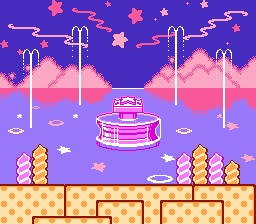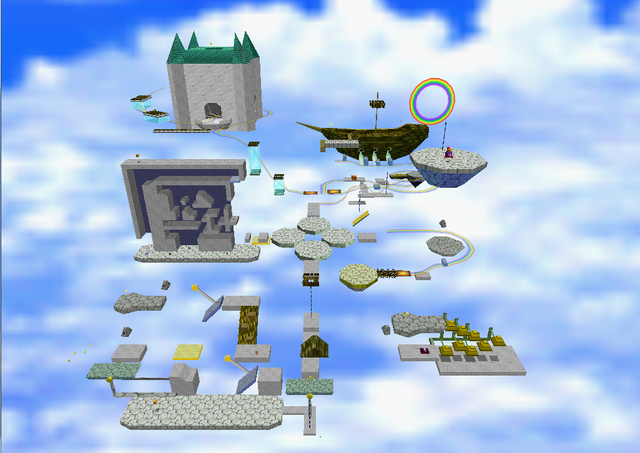I don't usually do this, but if you are strong smash fan, I really do recommend checking this video out.
Not the biggest fan of Melee but its aesthetics really do stick out in making it a unique title.
Hope when Smash 6 rolls round, it also comes with an aesthetic/art-style that make its stand. Maybe going for a cel-shaded style like those mods
Just watched it. Loved every bit.
Melee really does feel like a product of its time in the best way possible, and the sinister undertones of the game with the whole focus on computer graphics and surreal setpieces makes it stand the test of time from later releases. In an age where every Smash game feels less distinct from the last, it's really refreshing to see a deep dive analysis into what made the aesthetics of the older titles click.
One aspect of Melee's "off"-looking character designs that I find fascinating to no end is how it was more or less the one game that tried to render all of these characters in high quality without having a standardized base to reference. There was no Mario Sunshine to reference Mario's proportions and facial structure, so he's based moreso on N64-era renders of him. DK draws most of his inspiration from Rare's artwork of him and DKC, since Jungle Beat hadn't yet existed to provide his standard appearance. Link feels like what Ocarina of Time would've looked like in an alternate universe where it released on the GCN instead of N64.
This extends to the stages too. Seeing Peach's Castle in a more realistic manner after experiencing it in the bright palette of Mario 64 is really interesting! What's even more interesting to me are the subtle changes they decided to make to its layout, not just for gameplay purposes but aesthetically too.
There's a new water grate at the bottom right of the castle where the metal door (that leads to the basement) was in the original. The horseshoe bend path in the original has been changed into a three-way intersection (four if you count the bridge) with a nice little flower patch in the middle. Keep in mind, you don't even
see these details during gameplay. But they are there.
One of my favorite parts of Melee's stages are the liberties they take, too. Fountain of Dreams kind of had to do this since the OG version leaves a lot to the imagination, but it still looks like a fantastical marvel regardless. It's the most "magical" looking stage in Melee, but even then it still somehow retains that Y2K era grit?? If that makes sense? For as colorful as it is, the palette still feels a little washed out; they held back on cranking up the saturation all the way to preserve the stage's "Melee-ness".
Likewise with Icicle Mountain interpreting Ice Climber's stages in a more modern light, replacing the fun blocks with shoddy-looking scaffolding. The game also lists its greater location as
"Infinite Glacier", which I think about a lot. It's so raw and that little line of text adds a layer of mystique I never thought possible to this stage.
My favorite example of this, however, is Rainbow Cruise. In Mario 64 it's just a jumbled collection of platforming assets n' crap floating in the middle of nowhere. Almost like the devs threw their hands up cause they needed a 15th stage and were strapped for time, so they threw leftover platforms and test assets together into one level and called it a day.
Melee's version, however, contextualizes this mess in a very interesting way. For starters, the platform layouts is a lot more... eloquent? Organized? It's still got an element of chaos to it, but elements like the flying ships and floating platforms have a lot of new regal-looking patterns and embellishments on them. The original's setpieces consist of mainly blunt stone platforms that get the job of "something to stand on" done and nothing more. Melee's platforms do away with those, because Melee is
next-gen. It has checkered platforms whose bottom sides are tapered.
Melee also not only adds a mountain range to this area, bringing this obstacle course a lot closer to ground level but still dizzyingly high up, but a
village. A village that only appears in Melee, not Ultimate.
That damn village.
When you think about it, it's so out of place compared to what the rest of the stage is all about. In this sea of fantastical flying ships and ornate platforms suspended in thin air, you have this humble collection of houses just sitting there on a cliffside that doesn't even exist in the original game.
It's tiny. It's an incredibly minor detail. Compared to everything else going on in this chaotic stage, it's easy to miss. They could have just not added it. It doesn't have to be there.
But it
is there. Someone on the development team made a conscious effort to place that tiny little town there on that massive mountainside. Which begs the question of,
why? Why is it there? Why did Melee's developers decide this little additional detail was necessary?
It's so fascinating to me. What was the thought process there? Did they think it would look good, or that the stage just needed that little extra something? Was it approved by Mario 64's staff? Could this village have even been in line with what the developers of Mario 64 envisioned for the stage in the original game? Was Melee's Rainbow Cruise what the devs of the original stage
intended but couldn't accomplish due to technical and/or time constraints? Mario 64 itself is a very enigmatic game with areas that leave a whole lot up to the imagination. It isn't likely, but to think that this village could've been an interactable sub-area of Rainbow Cruise's main stage, possibly accessible by warp pipe or other means, just piques my interest to no end.
Melee is just
cool, man.
It was made in the right place, on the right hardware, at the right time. There isn't much else like it.

 Peach and Bowser definitely makes sense as the next two additions, and they even tried to get Bowser in sooner. Doctor Mario was a clone for funzies.
Peach and Bowser definitely makes sense as the next two additions, and they even tried to get Bowser in sooner. Doctor Mario was a clone for funzies.












